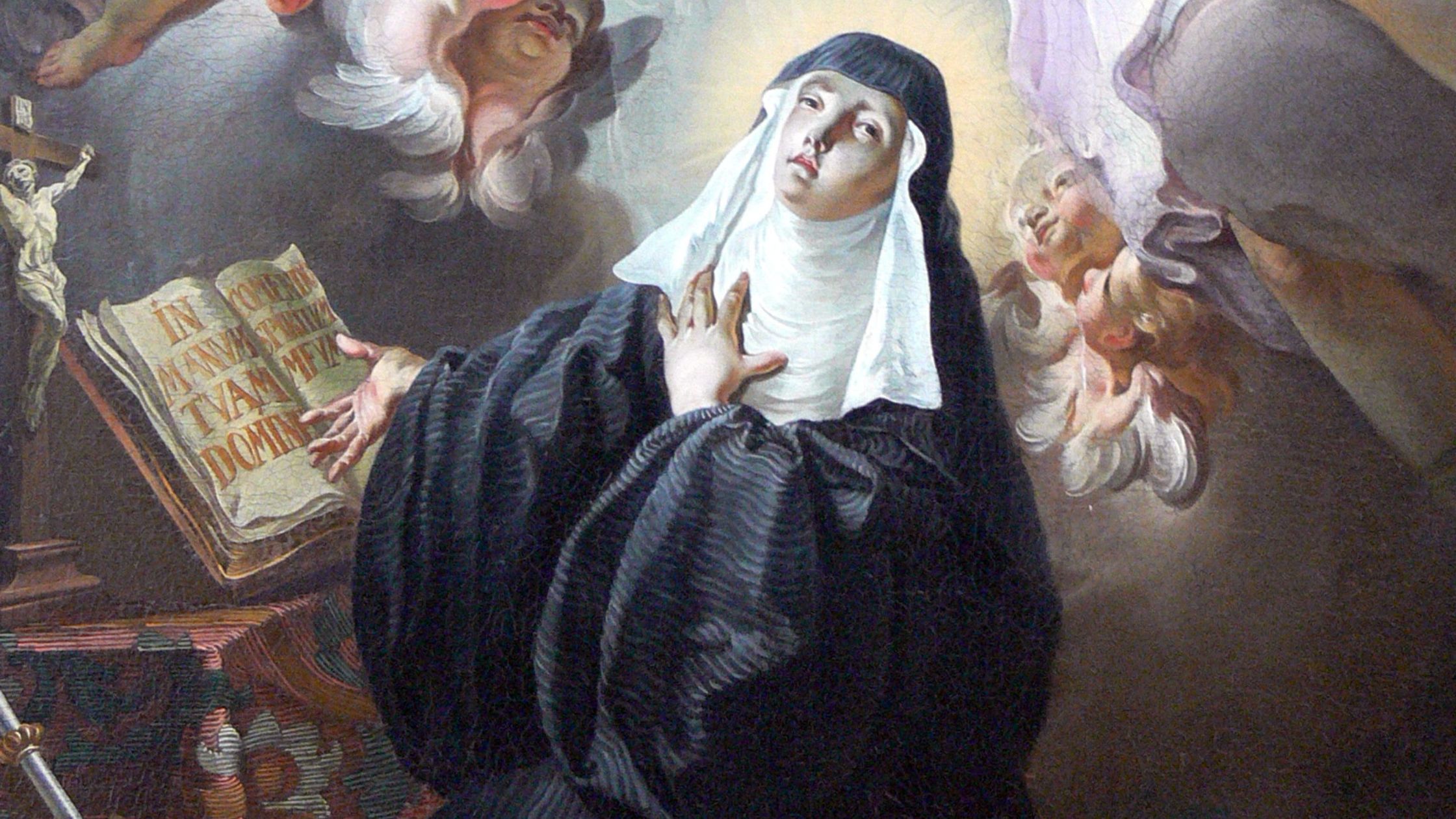“Their minds had always been united in God; their bodies were to share a common grave.”
– St Gregory the Great on St Scholastica and St Benedict
Who was St Scholastica?
Today’s saints are written by Fr Nicholas Schofield in Saints of the Roman Calendar.
St Scholastica (+ c.543) was the sister of St Benedict. She followed the rule of her brother near Montecassino and is regarded as the first Benedictine nun. When she met her brother for the last time, a sudden rainstorm providentially prolonged the meeting; three days later St Benedict saw her soul ascend to heaven as a dove (her symbol in art).
Collect for St Scholastica
As we celebrate anew the Memorial of the Virgin Saint Scholastica, we pray, O Lord, that, following her example, we may serve you with pure love and happily receive what comes from loving you. Through our Lord Jesus Christ, your Son, who lives and reigns with you in the unity of the Holy Spirit, one God, for ever and ever.
Collecta
Beatæ Scholasticæ virginis memoriam recolentes, quæsumus, Domine, ut, eius exemplo, tibi intemerata caritate serviamus et felices obtineamus tuæ dilectionis effects. Per Dominum nostrum Iesum Christum Filium tuum, qui tecum vivit et regnat in unitate Spiritus Sancti, Deus, per omnia sæcula sæculorum.
Today’s Gospel: Luke 10:38-42
In the course of their journey Jesus came to a village, and a woman named Martha welcomed him into her house. She had a sister called Mary, who sat down at the Lord’s feet and listened to him speaking. Now Martha who was distracted with all the serving said, ‘Lord, do you not care that my sister is leaving me to do the serving all by myself? Please tell her to help me.’ But the Lord answered: ‘Martha, Martha,’ he said, ‘you worry and fret about so many things, and yet few are needed, indeed only one. It is Mary who has chosen the better part; it is not to be taken from her.’
How is Mary the Model of Consecrated Life?
Written by Sr Mary David OSB in A Divine Gift.
“[The evangelical counsels] are able to more fully mould the Christian man to that type of chaste and detached life, which Christ the Lord chose for Himself and which His Mother also embraced.” (Lumen Gentium 46)
Of all those called by God to share in his holiness, to be consecrated to him through Jesus Christ in the power of the Spirit, no one responds more fully than Mary, the mother of the consecrated one.
The close relationship between Mary and the consecrated life has always been a conviction of the Church. The Church’s tradition sees her consecrated to God in the temple at a very young age. When she was received at the temple, Our Lady entered the service of God. Many Church Fathers, such as St Athanasius, St Ambrose, St Augustine and St Jerome, believed that she had taken a vow of virginity to express her exclusive devotion to God. This led many medieval authors to call Mary the foundress of the consecrated life.
In order to prepare Mary for her role, after her Son, as prototype of all consecration, God consecrated her in advance, from the first moments of her existence in the immaculate conception, to the assumption, which unveiled and consummated her perfect union with God. We may also think of her as the foundation of the consecration of Christ for she gave him the humanity which allowed him to be king and priest and victim of the redemptive sacrifice. She is also the prototype of the consecration of the Church and of each Christian. She is the model of a life entirely consecrated to God, at every instant and in every dimension of her being.
Christ shares with Mary his total consecration to the Father, so that she too may make – in him and through him – a total, loving consecration of herself to God: “Behold the handmaid of the Lord, let it be done unto me according to thy word” (Lk 1:38). Her fidelity to her Son accompanies him even to the cross, where she stands as the Church – the consecrated people of God – one with Jesus in his consecration to the Father.
“As the sublime model of consecration to the Father, union with the Son and openness to the Spirit, …Mary in fact is the sublime example of perfect consecration, since she belongs completely to God and is totally devoted to him. Chosen by the Lord, who wished to accomplish in her the mystery of the Incarnation, she reminds consecrated persons of the primacy of God’s initiative.” (VC 28)
As Our Lady shows, the primary subject of the consecration is God; God consecrates the person who commits himself to such a way of life, lays his hand on him. In its fundamental meaning, consecration is divinisation, the taking possession of someone or something by God himself, in view of their transformation. However, consecration also includes a response to his call, the solemn and special act by which a person assents to this act of consecration. The religious, like Our Lady, hands over the whole of his life to the service of God; he is at the service of God’s plan by that gift of self. Christ and his Mother show us the beauty and the great worth of a life totally consecrated to God. Their entire earthly life was nothing but a constant “yes” to the Father.
Want the Saint of the Day sent straight to your inbox? Sign up for our Saint of the Day emails and we’ll help you get to know the saints by sending you an email on the feast or memorial of every major saint, and on the optional memorial of select other saints. Opt out at any time.

